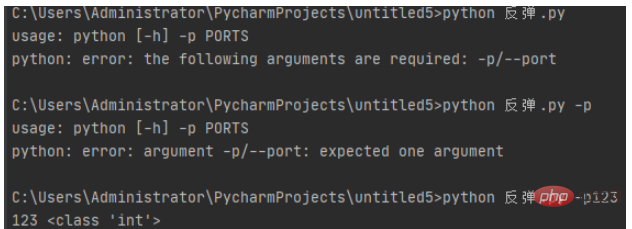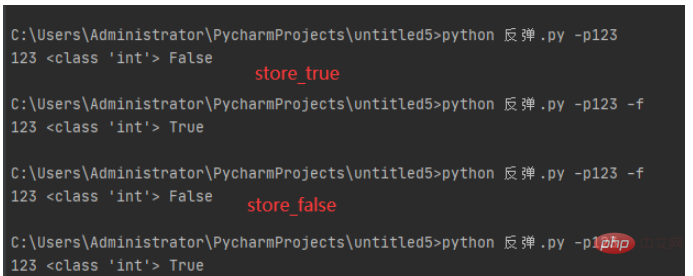How to use python command line parameter module argparse
May 03, 2023 pm 01:31 PMThe argparse module in Python is a command line argument parser that allows developers to easily write user-friendly command line interfaces.
The argparse module can automatically parse parameters from the command line, convert them into objects in Python, and provide some additional functions, such as automatically generating help documents, parameter type checking, etc.
The core of the argparse module is the ArgumentParser class. You can use this class to define the parameters and options that the program needs to receive.
Four steps to use argparse
Import the argparse package— —import argparse
Create ArgumentParser() object
Call the add_argument() method to add parameters
Parse command line parameters——Use parse_args() to parse the added parameters
Parameters of method add_argument:
def add_argument(self,
*name_or_flags: str,
action: Union[str, Type[Action]] = ...,
nargs: Union[int, str] = ...,
const: Any = ...,
default: Any = ...,
type: Union[(str) -> _T, (str) -> _T, FileType] = ...,
choices: Iterable[_T] = ...,
required: bool = ...,
help: Optional[str] = ...,
metavar: Union[str, Tuple[str, ...], None] = ...,
dest: Optional[str] = ...,
version: str = ...,
**kwargs: Any) -> ActionExample
parser=argparse.ArgumentParser("python")
parser.add_argument("-p", "--port",help="port to listen",type=int,nargs=5,dest="ports")
args=parser.parse_args()
print(args.ports,type(args.ports))
Explanation:
-p,–port, parameter name, help: Help information, type: the type of parameter being converted, nargs: read the number of command line parameters, multiple parameters are converted into a list, dest: the parsed parameter name
parser.add_argument("-p", "--port",help="port to listen",default=8080,type=int,dest="ports")
args=parser.parse_args()
print(args.ports,type(args.ports))default: default value

parser.add_argument("-p", "--port",help="port to listen",required=True,type=int,dest="ports")required: Whether it is a required parameter or an optional parameter

parser=argparse.ArgumentParser("python")
parser.add_argument("-p", "--port",help="port to listen",required=True,type=int,dest="ports")
parser.add_argument("-f","--flags",action="store_true")
args=parser.parse_args()
print(args.ports,type(args.ports),args.flags)action: When with store_true, you pass in Corresponding parameter, the parameter is true, otherwise it is false, and the opposite is true for store_flase

parser.add_argument("-l",choices="12345")
choices,参数l的取值只能是12345,1,2,3,4,5,12,123,1234等,不能是其它,不能乱序
The above is the detailed content of How to use python command line parameter module argparse. For more information, please follow other related articles on the PHP Chinese website!

Hot Article

Hot tools Tags

Hot Article

Hot Article Tags

Notepad++7.3.1
Easy-to-use and free code editor

SublimeText3 Chinese version
Chinese version, very easy to use

Zend Studio 13.0.1
Powerful PHP integrated development environment

Dreamweaver CS6
Visual web development tools

SublimeText3 Mac version
God-level code editing software (SublimeText3)

Hot Topics
 What are the advantages and disadvantages of templating?
May 08, 2024 pm 03:51 PM
What are the advantages and disadvantages of templating?
May 08, 2024 pm 03:51 PM
What are the advantages and disadvantages of templating?
 Google AI announces Gemini 1.5 Pro and Gemma 2 for developers
Jul 01, 2024 am 07:22 AM
Google AI announces Gemini 1.5 Pro and Gemma 2 for developers
Jul 01, 2024 am 07:22 AM
Google AI announces Gemini 1.5 Pro and Gemma 2 for developers
 For only $250, Hugging Face's technical director teaches you how to fine-tune Llama 3 step by step
May 06, 2024 pm 03:52 PM
For only $250, Hugging Face's technical director teaches you how to fine-tune Llama 3 step by step
May 06, 2024 pm 03:52 PM
For only $250, Hugging Face's technical director teaches you how to fine-tune Llama 3 step by step
 Share several .NET open source AI and LLM related project frameworks
May 06, 2024 pm 04:43 PM
Share several .NET open source AI and LLM related project frameworks
May 06, 2024 pm 04:43 PM
Share several .NET open source AI and LLM related project frameworks
 A complete guide to golang function debugging and analysis
May 06, 2024 pm 02:00 PM
A complete guide to golang function debugging and analysis
May 06, 2024 pm 02:00 PM
A complete guide to golang function debugging and analysis










